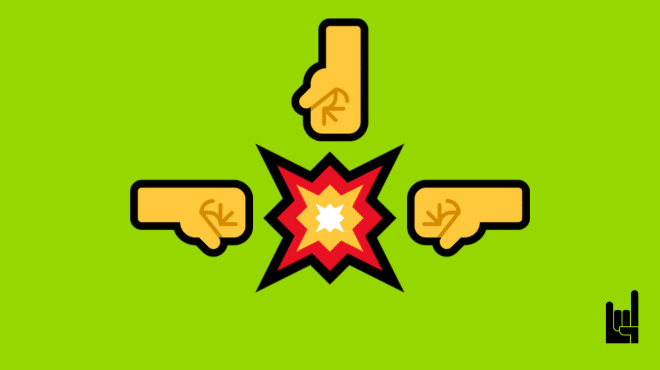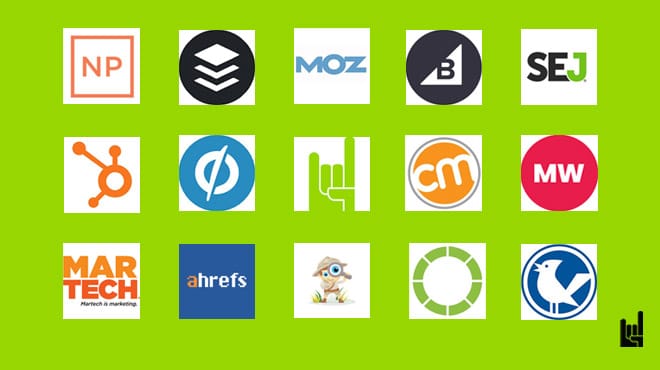You’ve heard the terms more than once yet you still aren’t sure what they mean. Let alone concepts like NFT Marketing.
It’s time this changed.
By the end of this guide, you will have a good idea of what’s going on in this bizarre NFT world. And what this ‘NFT’ means for marketing – and potentially for your business.
You probably have many questions so let’s start answering them immediately, in the correct order.
What is Web 3.0?
Before we even think about explaining NFTs, we need to give some background first and talk about Web 3.0.
Web 3.0 focuses on decentralization, blockchain technology, and token-based economics. NFTs are just another of Web 3.0’s components.
Too much jargon – I know, but try to keep up with me for a moment. As the name suggests, Web 3.0 is the third version of the Web. So, naturally, to understand better this third version of the web, we have to understand what the former versions looked like.
Web 1.0 (1991 – 2004)
On August 6, 1991, the world’s first website went live, running on a computer at CERN. One of the key people behind this great achievement was Sir Timothy-Lee, the inventor of the World Wide Web. And thus, Web 1.0 was born: the first version of the world wide web.
Web 1.0 was a less interactive version of the Web as we know it today.
During these early days of the WWW, you would usually interact with the Web as much (or as little) as you would interact with your TV. You would pick, or rather type, the websites you wanted to visit the same way you’d pick the channels on your remote control. And then you’d stare at the screen and consume the content you would have on the screen in front of you.
It was one-way communication. You wouldn’t comment on anything, you wouldn’t subscribe to anyone, and most certainly, you wouldn’t add any friends anywhere.
Web 1.0 was one huge online brochure. Until Web 2.0 came along.
Web 2.0 (2004 – Today)
Whereas Web 1.0 was a cluster of static pages, the entirety of Web 2.0 was built with Dynamic HTML.
Web 2.0 is the web we know best, the current state of the web.
As Darcy DiNucci, the information architecture consultant, wrote in January 1999, in her article Fragmented Future:
“The Web we know now, which loads into a browser window in essentially static screenfuls, is only an embryo of the Web to come. The first glimmerings of Web 2.0 are beginning to appear, and we are just starting to see how that embryo might develop. The Web will be understood not as screenfuls of text and graphics but as a transport mechanism, the ether through which interactivity happens. It will […] appear on your computer screen, […] on your TV set […] your car dashboard […] your cell phone […] hand-held game machines […] maybe even your microwave oven.”
Web 2.0 introduced many features that we now take for granted: blogs, wikis, social media & social networking sites, video sharing & image sharing sites, web apps, and more. In this version of the Web, any user was at the same time a potential creator. This new dynamic gave birth to constructs like user-generated content, internet communities, podcasts, and even SaaS (Software as a Service).
Needless to say, in the vast sea of Web 2.0, new industries and concepts emerged, such as digital marketing and growth hacking.
Web 3.0 (Today – ?)
Web 3.0 is an idea for a new iteration of the Web. Some features that could help define this version of the Web are decentralization, AI, and blockchain technology. The best one-line definition I can come up with is this:
Web 3.0 dreams of a decentralized digital landscape based on blockchain technology.
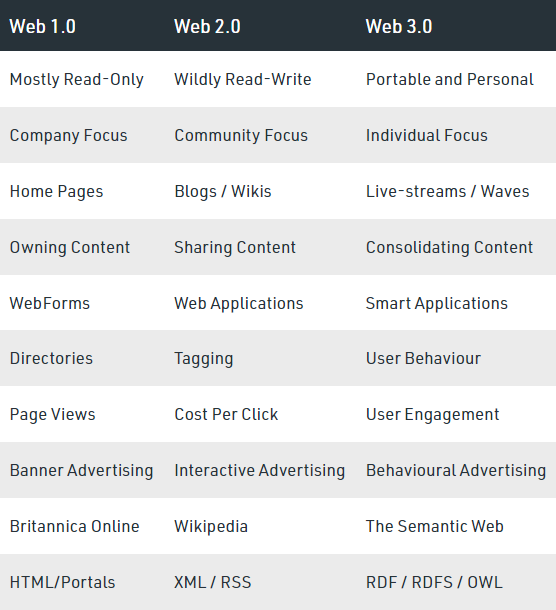
Web 3.0 actors such as Web 3.0 marketing agencies and blockchain development companies seek to create a more intelligent and open digital world. A digital world that won’t be as dependent, as shaped, and as manipulated by The Big Tech companies.
It should be noted that it’s difficult to define Web 3.0 today, let alone Web 3.0 marketing, for the same reasons it was difficult to define Web 2.0 before it came into full existence. For now, the definition we have allows us to dive deeper into our next chapter: NTFs.
What are NFTs?
Now that you know more about the internet, it’s time for the real question: WTF are NFTs?
Here’s the Wikipedia definition of an NFT: An NFT (non-fungible token) is a non-interchangeable unit of data stored on a blockchain, a form of digital ledger, that can be stored in a wallet or sold and traded.
Unfortunately, if you don’t know what blockchain is, then this definition shouldn’t make much sense to you.
I know, know – we yet again have to give a definition to explain another definition.
But it will be the last time – I promise.
So, let’s get to it!
What is Blockchain?
If we could describe blockchain with one word, that would be a database. At its core, blockchain is a decentralized database shared across the network, a list of records. It is a ledger through which data is added and updated in real time.
A good analogy that is usually given to describe blockchain is Google Docs. You know Google Docs. It is an online word document where we write things. At any time we can share this document with anyone, so they can start writing on the document as well. In the case of blockchain, no actual writing is involved, but rather the register of transactions, is updated in the document in real time.
To sum up our analogy, blockchain is a Google Doc you share with whoever you want to make a transaction with, with every transaction being noted down in this document. There are, however, two main differences regarding this analogy.
Difference #1: Data can only be added and can’t be removed or edited. It’s like the ultimate history book where the book writes down everything in the exact way that is happening and nothing can be rewritten.
Difference #2: In the case of Google Docs, the one who created the document is also the owner of the document. Therefore, he has complete power over the document. But this is not the case for blockchain. Remember the “decentralization” part that Web 3.0 was raving about? This is where it becomes relevant. No one owns this list of transactions.
Before blockchain, every digital transaction would need the authorization of a central authority – the banking system.
After blockchain, no middleman/ authority is needed for any exchange between individuals.
Now that you know what (a) blockchain is, we can also understand what an NFT is.
What is an NFT?
NFT stands for “non-fungible token”. Since this doesn’t help a lot, let’s break it down a bit. The first part is “non-fungible” which means unique; a digital entity that can’t be replaced. The second part is a token; is a digital certificate.
At its core, an NFT is a digital asset that links ownership to unique digital items, usually a form of media such as images, videos, and music.
I know how much you love examples and diving deeper at this point, so I will deliver immediately.
Remember all these years in the fine art industry and the amount of money that was involved in buying and selling art? When rich folk would gather in auction houses and outbid one another for hundreds of thousands, and sometimes, millions of dollars for a Rothko painting? And how all of this looked very bizarre to us mere mortals?
Well, now it’s the same thing all over again. But this time digitally! And we mere mortals can partake in this madness!
Here’s how it works.
You know Davinci’s most famous piece of art – the Mona Lisa. You probably also know that the original Mona Lisa painting resides in the Louvre museum, in Paris. Most of us haven’t been to Louvre but we all know what Mona Lisa looks like. We do so because there have been countless reproductions of the painting in various ways: it’s been photographed, it’s been recorded on video, it’s been printed on posters, postcards, T-shirts, clocks, and on any imaginable surface.

To take it a step further, a master of art could create such a flawless replica that no human eye could tell between the original and the replica. But still, the one in Louvre would remain the original – the Mona Lisa – no matter how many other Mona Lisas are or how identical they are.
Now, what happens with NFTs is pretty similar. Only this time, the lines of value become even thinner. Because the digital world is less tangible than the physical world.
For example, do you know this cat? Of course, you do, it’s the Nyan Cat.
https://giphy.com/gifs/nyan-cat-sIIhZliB2McAo
Last year it was sold for $580,000.
– Do you mean this gif above?
– No, you silly! Not this gif.
– Which gif then?
– The original gif, of course!
– And how are they different?
– Good question. They aren’t that different.
Are you starting to understand the NFT world a bit better now?
Original pieces of art would change hands, for a hefty price in auction houses.
Now, NTFs change hands, for a hefty price, on NFT marketplaces.
And the technology used for keeping track of these NFT purchases is blockchain.
BOOM! We just squared the circle! Now you know all the basics 🙂
This means that we can move on to the business side of NFTs. Shall we?
What Do NFTs Mean for Your Businesses?
NFTs are relatively young, and the future of NFTs is ambiguous, but we can still draw conclusions on what NFTs mean for your business.
You probably know at least one example where a popular brand used NFT for a marketing campaign that created a buzz. We’ve also included 5 such instances where well-known brands leveraged NFTs for their own campaigns, in the last chapter of this article.
Nonetheless, no matter how many case studies from multinational companies we publish, this probably won’t help you answer What can NFTs do for my business?
NFTs can impact the marketing of a small business in different ways, like:
- Build brand awareness
- Expand its audience reach
- Promote events
- Drive pre-orders
- Support a good cause
Here are some ways you can use NFTs in practice, according to Inc:
1. Counterfeit-proof issuance of single-use promotional tools: coupons, promotional discounts, event tickets, BOGO deals, etc. Blockchain codes or QR codes serve as uncopyable, tamper-proof access/discount assets with a wide array of use cases.
2. Establishing a customer loyalty program: Consider a digital NFT loyalty card. Once customers sign up for it, they download it to their mobile devices. Every time they visit your business, they scan the loyalty NFT code to accrue loyalty points. At certain thresholds, you can push rewards, discounts, or blockchain tokens to be used in-store.
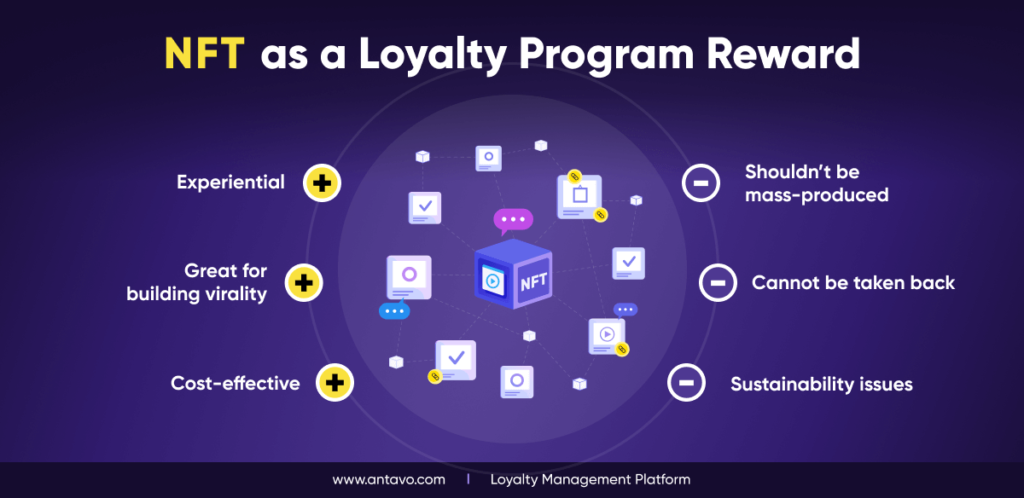
3. Cause-related marketing and charity support: NFTs were used to raise money to help empower Afghan women in the aftermath of the recent US exodus. A similar program could be duplicated at the neighborhood, town, city, or state level to spur geographic-affinity marketing or support local charities.
4. Secure fundraising for expansion: If your business is considering opening another location or expanding your existing site, an NFT campaign could be a low-cost funding alternative to a traditional bank business loan. Think of it as a scam-proof Kickstarter: A crowdfunding campaign where donors know and track that money, which is only issued if milestones are reached as determined by smart contracts established at the start of the campaign.
5. Sweepstakes or gamification types of promotions: These types of marketing campaigns can be expensive to run and usually only make sense for large enterprises, such as McDonald’s franchises that participate in Monopoly game pieces or Publishers Clearing House, which still uses sweepstakes marketing. With a little creativity, NFTs bring the possibility of highly engaging gamification marketing to small businesses. For example, a Chamber of Commerce could launch a digital NFT scavenger hunt involving dozens of locally-owned businesses to drive customer traffic to each location. The potential is limited only by imagination.
NFT Marketing Case Studies
It’s time to see some of the biggest plants on the planet leverage NFTs for their own marketing campaigns.
Here are some of the most successful NFT marketing case studies.
1. Pizza Hut: One Byte Favorites

Last year, Pizza Hut Canada created four new pizza flavors. And as it usually goes with these debuts, the brand needed a fiery promo campaign to make said debut stand out.
And so in March 2021, Pizza Hut debuted “1 Byte Favorites”, the world’s first non-fungible pizza. Each week, it would release an NFT featuring a pizza slice – one slice for every new flavor. These NFTs would be “available for an extremely limited time but would last forever”.
It should be noted that Pizza Hut didn’t run this NFT marketing campaign for money but rather for awareness. Accordingly, each NFT was originally sold for $0.18, which corresponded to one bite of pizza. However, once it was purchased it was quickly re-listed for 5 ETH or about $9,000 at the time.
Currently, only one of these slices is for sale, for 75 ETH (currently $200,000). Hey, if you’ve got the cash or the ETH in this case, we don’t judge; you can purchase it here.
2. NBA: Top Shots

NBA Top Shots is one of the most successful, if not the most successful, NFT marketing case studies. To better understand the craze around NBA Top Shot and its success, this number will suffice: the platform went from 4,000 to 400,000 users in a matter of weeks.
This didn’t happen by accident. The team responsible for this success was Dapper Labs, the designers of CryptoKitties, the world’s first popular game based on blockchain, originally created in 2017.
Back to NBA Top Shots, the best way to describe it is as a digital trading card game. But instead of cards, there are clips – highlights from major plays in NBA history. Each one of these highlights is called a Moment. Much like Magic the Gathering or Pokémon cards, you can buy these Moments in packs, and every Moment has a certain rarity, namely Common, Rare, and Legendary.
Up to this day, a big number of Moments are traded every moment in the NFT marketplace dedicated to this game, NBA Top Shot. Wanna give it a shot?
3. Adidas: Into the Metaverse

This one is one of the most recent success stories of NFT Marketing. In December 2021, Adidas entered the realm of NFTs. And like that, in a single afternoon, it sold 30,000 NFTs, worth $22 million.
But Adidas wasn’t alone in this. The clothing brand teamed up with some big names from the NFT and crypto world to pull this off: Bored Ape Yacht Club, Punks Comic, and Gmoney.
As Adidas Originals Marketing and Communications Vice President Erika Wykes stated to bitcoin.com News: “As part of our ambition to celebrate ideas that are defining a new age of originality, we’ve landed at the forefront of creativity, which is the open metaverse.”
In contrast to most things related to NFTs, this campaign from Adidas also had an impact on the physical world. Besides the token itself, NFT buyers would also get access to physical Adidas such as unique tracksuits, hoodies, and beanies.
4. Nike: RTFKT Digital Sneakers
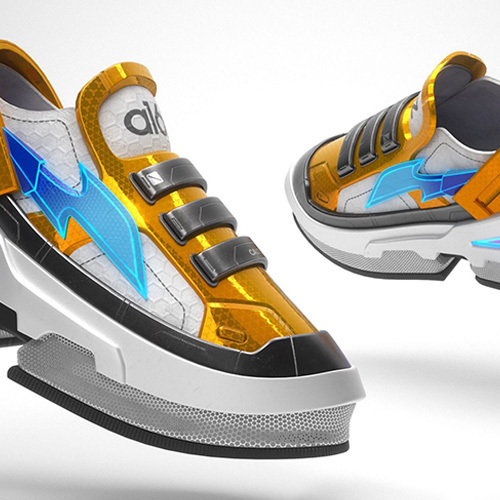
It all started in December 2019, when the US Patent Office issued sportswear brand Nike‘s patent for its blockchain-compatible sneakers dubbed “CrpytoKicks. The patent describes the mechanism through which blockchain technology is used to authenticate physical products.
In Nike’s case, this mechanism can help the shoe Brand track the ownership and verify the authenticity of a pair of sneakers. In practice, someone who buys a pair of “CryptoKicks” will also receive a digital asset attached to a unique identifier of that shoe. This creates a digital scarcity of digital assets since their production is tied to the production of real sneakers. Therefore, when sneakers are sold, ownership can be transferred by trading both real shoes and/or associated digital assets.
But Nike’s aspirations regarding the use of new technology and digital realities didn’t stop there. Two years later, in December 2021, Nike acquired RTFKT, a virtual shoe company that makes digital shoes. A few months prior to that, RTFKT had managed to sell 600 pairs/NFTs netting over $3.1 million in a few minutes. Everything points to the fact that Nike is looking ahead for new ways to create -literally- unique virtual products and experiences.
5. Kings of Leon: NFT Yourself
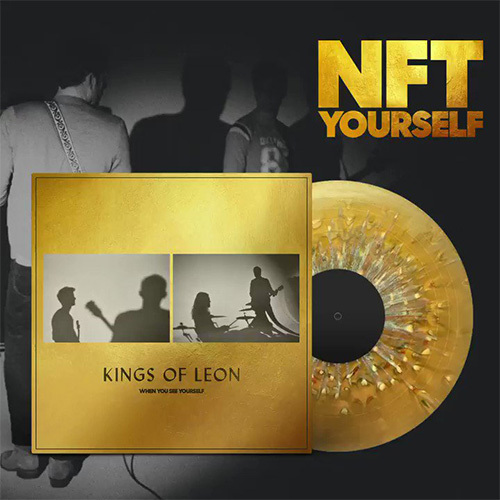
Our list so far consists mostly of examples with brands that you can either eat or wear. So here’s something different that happened in March 2021. The American rock band Kings of Leon, in partnership with crypto start-up YellowHeart, became the first band to sell their newly-released album in the form of an NFT.
Three different kinds of tokens were involved in this campaign: The first type was standard audiovisual art NFTs, the second was a special album package along with a limited-edition vinyl print, and the third type of token was offed live front-row seats for life.
In the end, it was not only a pretty successful NFT marketing campaign but also Kings of Leon managed to generate around $2 million in their NFT album sales, according to Digital Music News.
NFTs & NFT Marketing: Conclusion
NFTs are blurring the line between art and technology. Being a fresh concept, NFTs definitely bring a certain novelty to the table.
Big brands have shown what they can do with it. Now, smaller brands and businesses are looking to find how NFTs, NFT marketing, and blockchain technology will help them. Are you one of them?

Effie is a data-driven marketer and a specialist in data-driven strategies to drive growth. At the same time, she is a firm believer that nothing can beat a great idea so there’s no holding her back when it comes to creative, out-of-the-box concepts and delivering superior brand experiences. One of the things she enjoy the most is building and motivating high-performance marketing teams, like GrowthGirls’ and GrowthRocks’ teams of growth marketers and also teaching aspiring growth marketers at Growth Hacking University. She has helped big multinational organizations as well as innovative startups to grow by offering a full spectrum of digital marketing services, from the strategic approach down to technical bit and bytes of the implementations, always having a hands-on approach to any project with a 100% focus on results. She is sharing here time between Europe and the US working with companies around the globe.

